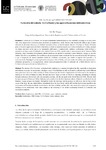Mostrar o rexistro simple do ítem
La lección del embalse. Le Corbusier y los aprovechamientos hidroeléctricos
| dc.contributor.author | Río Vázquez, Antonio S. | |
| dc.contributor.other | Universidade da Coruña.Departamento de Composición | es_ES |
| dc.date.accessioned | 2016-03-08T17:34:45Z | |
| dc.date.available | 2016-03-08T17:34:45Z | |
| dc.date.issued | 2015 | |
| dc.identifier.citation | «La lección del embalse. Le Corbusier y los aprovechamientos hidroeléctricos» en Jorge Torres Cueco (dir.), Le Corbusier. 50 años después, Universitat Politècnica de València, Valencia, 2015, p. 1861-1875 | es_ES |
| dc.identifier.isbn | 978-84-9048-373-2 | |
| dc.identifier.uri | http://hdl.handle.net/2183/16261 | |
| dc.description.abstract | [Resumen] El interés de Le Corbusier por los aprovechamientos hidroeléctricos es una constante a lo largo de su vida, sobre todo como inspiración y referencia para proyectar su arquitectura, dando forma a una lección del embalse que veremos enfocada de diferentes maneras y en distintos momentos, desde su descubrimiento durante el trabajo en Vienne (Francia) para la Société d’applications du bétón armé hasta el intento de materialización con la obra de Bhakra en la India, pasando por etapas sucesivas en las que se va exponiendo, publicando o compartiendo, mediante conferencias, textos teóricos o encuentros en viajes, como el realizado a los Estados Unidos en 1946, cuando visita el macroproyecto de la Tennessee Valley Authority y deja constancia en la primera edición americana de Quand les catedrales étaient blanches: voyage au pays des timides. A través de sus palabras, de sus dibujos y de sus proyectos vamos revelando las dos caras de la lección del embalse: la que se desprende de manera inmediata desde las realidades encontradas, que tendrá su impulso final paralelo a la construcción de Chandigarh con la implicación en la presa sobre el Sutlej; y la cara oculta, desvelada como aportaciones e influencias progresivas en su arquitectura. Ambas caras permanecerán como el testimonio de la fértil relación entre Le Corbusier y los aprovechamientos hidroeléctricos. | es_ES |
| dc.description.abstract | [Abstract] The interest of Le Corbusier on hydroelectric industry is a constant throughout his life, especially as inspiration and reference to project its architecture, shaping a lesson of the dam that we will see focused in different ways and at different times, from their discovery while working in Vienne (France) for the Société d’applications du bétón armé to the attempt to materialize the work of Bhakra in India, through successive stages in wich he will be in exposing, publishing or sharing through conferences, theoretical texts and encounters on trips, like the one made to the United States in 1946, when he visits the macro project of Tennessee Valley Authority and describes it in the first American edition of Quand les cathedrals étaient blanches: voyage au pays des timides. Through his words, his drawings and his projects we will reveal the two faces of the lesson of the dam: the one which follows immediately from the facts found, which will find the final attempt parallel to the construction of Chandigarh with the involvement at the dam on Sutlej; and the other side, unveiled as inputs and progressive influences in its architecture. Both sides remain as the testimony of the fertile relationship between Le Corbusier and hydroelectric industry. | es_ES |
| dc.language.iso | spa | es_ES |
| dc.publisher | Universitat Politècnica de València | es_ES |
| dc.relation.uri | http://dx.doi.org/10.4995/LC2015.2015.1007 | es_ES |
| dc.rights | Reconocimiento-NoComercial-SinObraDerivada 4.0 Internacional | |
| dc.rights.uri | http://creativecommons.org/licenses/by-nc-nd/4.0/ | |
| dc.subject | Arquitectura | es_ES |
| dc.subject | Siglo XX | es_ES |
| dc.subject | Le Corbusier | es_ES |
| dc.subject | Agua | es_ES |
| dc.subject | Industria | es_ES |
| dc.subject | Embalse | es_ES |
| dc.subject | Auga | es_ES |
| dc.subject | Reservoirs | es_ES |
| dc.title | La lección del embalse. Le Corbusier y los aprovechamientos hidroeléctricos | es_ES |
| dc.type | info:eu-repo/semantics/conferenceObject | es_ES |
| dc.type | info:eu-repo/semantics/conferenceObject | es_ES |
| dc.rights.access | info:eu-repo/semantics/openAccess | es_ES |






